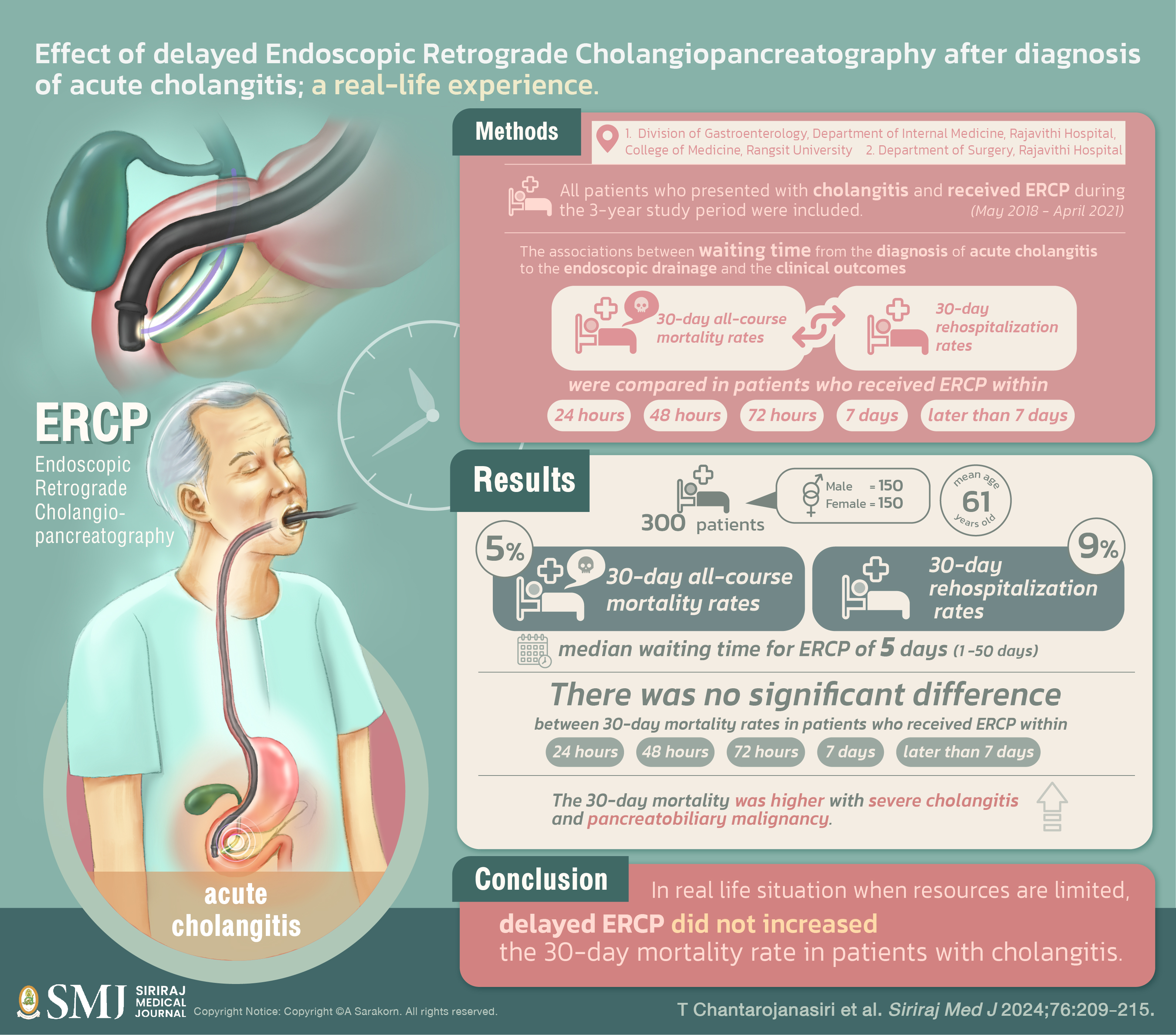Effect of Delayed Endoscopic Retrograde Cholangiopancreatography after Diagnosis of Acute Cholangitis; A Real-life Experience
DOI:
https://doi.org/10.33192/smj.v76i4.267489Keywords:
cholangitis, ERCPAbstract
Objective: Acute cholangitis is a potentially life-threatening condition. Its main treatments include antibiotics and biliary drainage, but longer waiting times for endoscopic biliary drainage may be unavoidable in some limited-resource settings.
Materials and Methods: All patients who presented with cholangitis and received ERCP during the 3-year study period were included. The associations between waiting time from the diagnosis of acute cholangitis to the endoscopic drainage and the clinical outcomes, including 30-day all-course mortality and 30-day rehospitalization rates, were compared in patients who received ERCP within 24 hours, 48 hours, 72 hours, 7 days, and later than 7 days.
Results: Overall, 300 patients were included. The 30-day all-course mortality rate was 5%, with 9% overall rehospitalization rate, and median waiting time for ERCP of 5 days (1 -50 days). There was no significant difference between 30-day mortality rates in patients who received ERCP within 24 hours, 48 hours, 72 hours and over 7 days (p > 0.05). The mortality rate was significantly higher in those with severe cholangitis and with pancreatobiliary malignancy (p < 0.05).
Conclusion: In real life situation when resources are limited, delayed ERCP did not increased the 30-day mortality rate in patients with cholangitis.
References
Kiriyama S, Kozaka K, Takada T, Strasberg SM, Pitt HA, Gabata T, et al. Tokyo Guidelines 2018: diagnostic criteria and severity grading of acute cholangitis (with videos). J Hepatobiliary Pancreat Sci. 2018;25(1):17-30.
Miura F, Okamoto K, Takada T, Strasberg SM, Asbun HJ, Pitt HA, et al. Tokyo Guidelines 2018: initial management of acute biliary infection and flowchart for acute cholangitis. J Hepatobiliary Pancreat Sci. 2018;25(1):31-40.
Navaneethan U, Gutierrez NG, Jegadeesan R, Venkatesh PGK, Butt M, Sanaka MR, et al. Delay in performing ERCP and adverse events increase the 30-day readmission risk in patients with acute cholangitis. Gastrointest Endosc. 2013;78(1):81-90.
Tan M, Schaffalitzky de Muckadell OB, Laursen SB. Association between early ERCP and mortality in patients with acute cholangitis. Gastrointest Endosc. 2018;87(1):185-92.
Schwed AC, Boggs MM, Pham XD, Watanabe DM, Bermudez MC, Kaji AH, et al. Association of Admission Laboratory Values and the Timing of Endoscopic Retrograde Cholangiopancreatography with Clinical Outcomes in Acute Cholangitis. JAMA Surg. 2016;151(11):1039-45.
Inamdar S, Sejpal DV, Ullah M, Trindade A. Weekend vs. Weekday Admissions for Cholangitis Requiring an ERCP: Comparison of Outcomes in a National Cohort. Am J Gastroenterol. 2016;111(3):405-10.
Mulki R, Shah R, Qayed E. Early vs late endoscopic retrograde cholangiopancreatography in patients with acute cholangitis: A nationwide analysis. World J Gastrointest Endosc. 2019;11(1):41-53.
Iqbal U, Khara HS, Hu Y, Khan MA, Ovalle A, Siddique O, et al. Emergent versus urgent ERCP in acute cholangitis: a systematic review and meta-analysis. Gastrointest Endosc. 2020;91(4):753-60.e4.
Zhu Y, Tu J, Zhao Y, Jing J, Dong Z, Pan W. Association of Timing of Biliary Drainage with Clinical Outcomes in Severe Acute Cholangitis: A Retrospective Cohort Study. Int J Gen Med. 2021;14:2953-63.
Lu ZQ, Zhang HY, Su CF, Xing YY, Wang GX, Li CS. Optimal timing of biliary drainage based on the severity of acute cholangitis: A single-center retrospective cohort study. World J Gastroenterol. 2022;28(29):3934-45.

Published
How to Cite
Issue
Section
Categories
License
Copyright (c) 2024 Siriraj Medical Journal

This work is licensed under a Creative Commons Attribution-NonCommercial-NoDerivatives 4.0 International License.
Authors who publish with this journal agree to the following conditions:
Copyright Transfer
In submitting a manuscript, the authors acknowledge that the work will become the copyrighted property of Siriraj Medical Journal upon publication.
License
Articles are licensed under a Creative Commons Attribution-NonCommercial-NoDerivatives 4.0 International License (CC BY-NC-ND 4.0). This license allows for the sharing of the work for non-commercial purposes with proper attribution to the authors and the journal. However, it does not permit modifications or the creation of derivative works.
Sharing and Access
Authors are encouraged to share their article on their personal or institutional websites and through other non-commercial platforms. Doing so can increase readership and citations.














